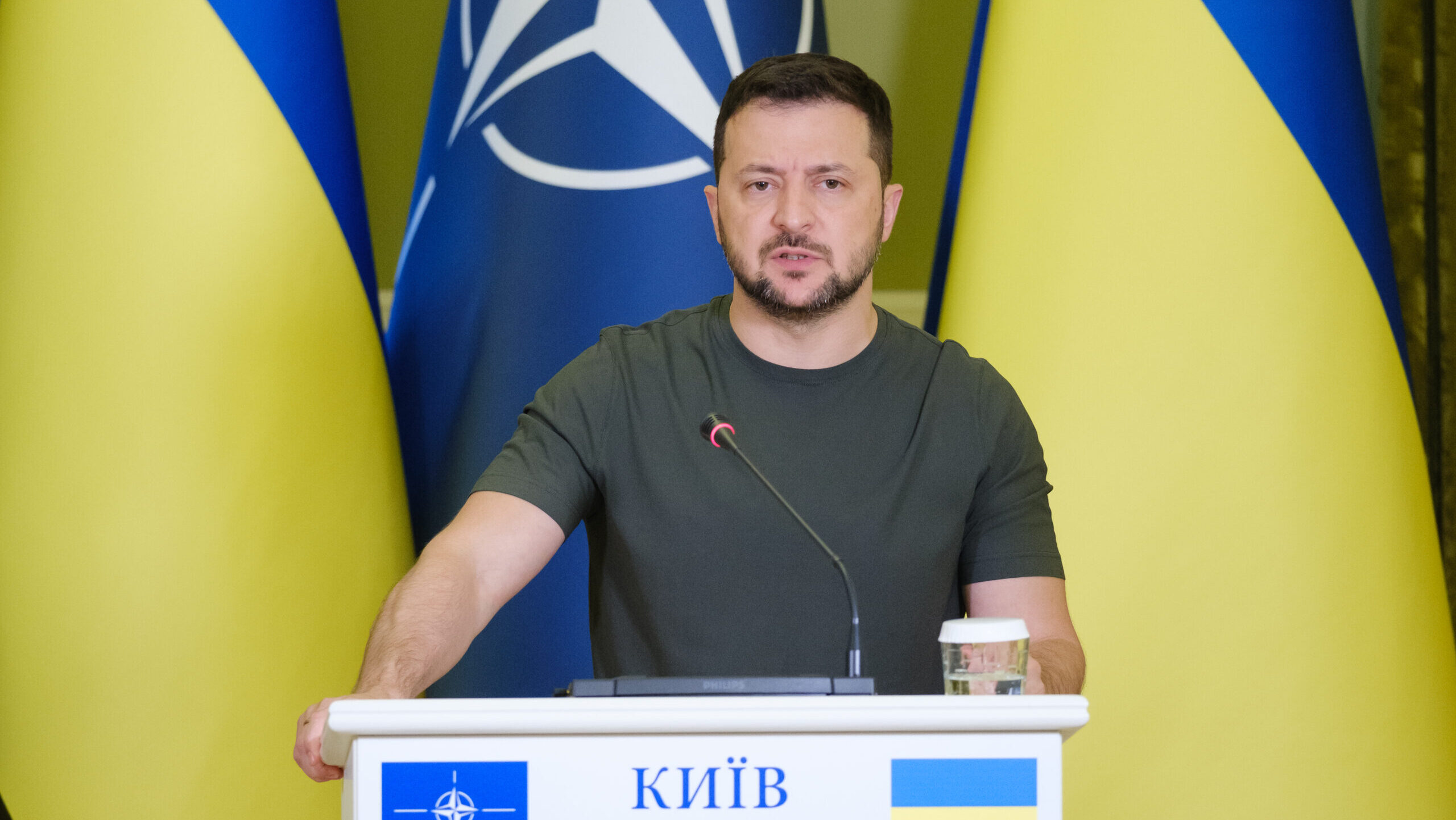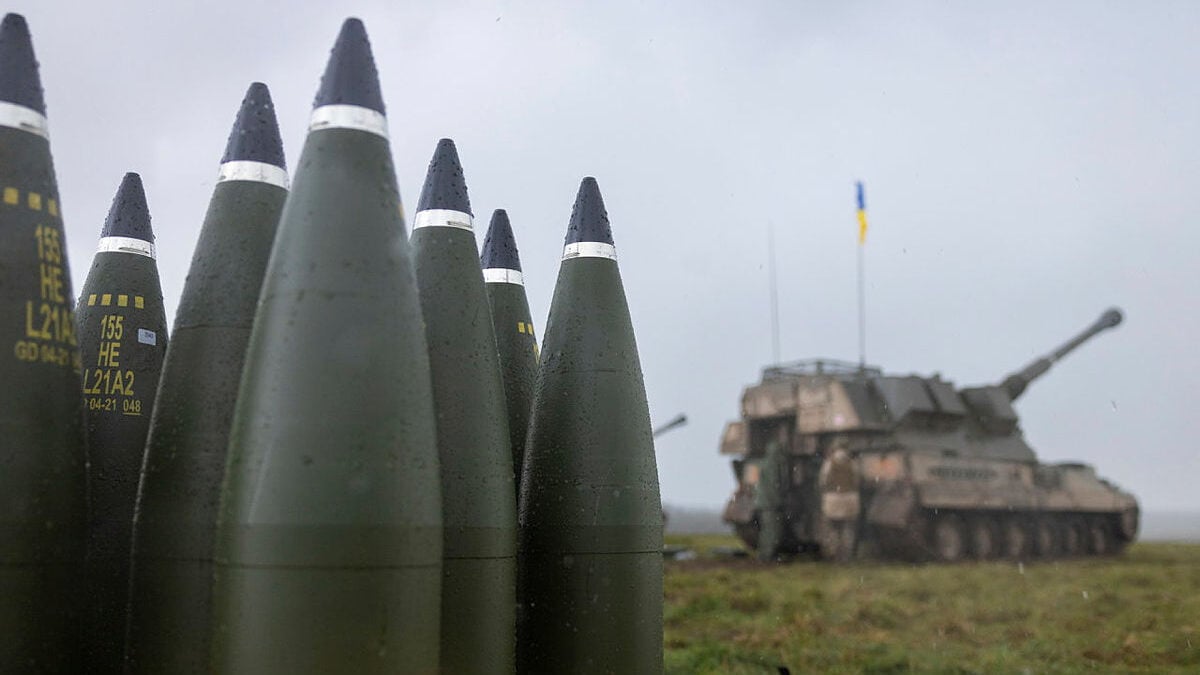
KYIV, UKRAINE – SEPTEMBER 28: President Volodymyr Zelenskyi during meeting with Secretary general of NATO Jens Stoltenberg on September 28, 2023 in Kyiv, Ukraine. (Photo by Vitalii Nosach/Global Images Ukraine via Getty Images)
It’s no secret that NATO and its partners are struggling to produce the level of defense materiel needed to support the defense of Ukraine. One idea is coproduction inside Ukraine, but that raises a host of difficulties. If only there was a better way.
In the following op-ed, Kateryna Bondar, a former advisor to Ukrainian Ministries of Defense and Finance, says that coproduction in NATO nations would be a win-win-win, providing host countries economic benefits, American industry with future sales, and Ukrainians a greater chance to push back on Putin’s invasion.
The situation in Ukraine offers the United States a distinct advantage in three primary areas: It affords the US defense industry a unique “testing ground” for the latest weapons and technologies, thereby strengthening and advancing US capabilities; it serves as a platform for bolstering transatlantic security and demonstrating US leadership in NATO; and it creates an opportunity for enhancing the US’s global influence, especially against the backdrop of rising competition with China.
The 2024 NATO summit presents a pivotal moment for the US to solidify the achievements of its strategy towards Ukraine. The Biden administration’s most viable political move might involve initiating accession discussions, mirroring the EU’s method with Ukraine for EU membership. However, accession talks alone are insufficient to fully deter Russia and to gain entry to Ukraine’s “battlefield testing lab.”
Recognizing that deterrence is production, a tangible step the US should take is to spearhead the formation of cooperative military-industrial partnerships with Ukrainian companies, both within the NATO framework and on NATO territory. Acknowledging the various challenges Ukraine faces as a partner, the US could lead in developing a detailed comprehensive framework encompassing legal, financial, investment and other considerations for initiating joint ventures under this scheme.
This framework could be presented as a precise, step-by-step process for all companies interested in collaboration under this initiative, right at the NATO summit in summer — a geopolitical win for the White House, resulting in both battlefield benefits for Ukraine’s defense and economic ones for partner nations.
A Coproduction Strategy
In recent months, the US and the EU have each released their first ever military-industrial strategies. A notable distinction is that the American approach emphasizes partnership with allies, whereas the European strategy prioritizes developing autonomy, especially from the US.
The EU plans to incorporate Ukraine as a partner in its military-industrial framework through the EU’s defense support program. This effort seeks to facilitate joint procurement and improve capabilities, bolster ties with Ukrainian startups, and set up an Innovation Office in Kyiv. Consequently, without quick action, the US may miss its chance, as European allies commit substantial resources and funds for collaborative development with Ukraine. The small scale and limited absorption capacity of Ukraine’s defense industry suggest that the window for taking a leading role is quite narrow.
It must be noted that the administration has already started shifting its approach to focus on enhancing Ukraine’s self-defense capabilities through development of its military-industrial complex. The White House intends to launch coproduction with the Ukrainian military-industrial base, but is starting slowly by sending an advisor to Ukraine’s Ministry of Strategic Industries and establishing interagency “Ukraine Deal Team” that will assist with guidance on deals and export requirements for Ukraine’s defense industry.
Ukraine presents unique challenges for military-industrial collaboration, significantly amplified by its active war, a primarily Soviet-era industrial base, and non-ally position. Internal challenges in Ukraine, including widespread corruption and centralized power in the Office of the President, weak institutions, inadequate protection of investor and intellectual property rights, and difficulties in safeguarding production and staff against Russian attacks, further complicate collaboration.
All these factors will likely push the US to prioritize reforms in Ukraine over the immediate launch of co-production. That’s a mistake, because there simply isn’t time, and because there is an alternative: The new joint ventures that include both Ukrainian defense firms and American ones could be established in NATO countries.
Moving to NATO means the key concerns about coproduction Ukraine no longer exist. The new businesses would benefit from physical protection due to the low likelihood of a Russian attack on a NATO member. Moreover, their intellectual property rights and investments would be safeguarded by European legislation, while technology would be protected from Russian espionage by the advanced security and intelligence agencies of European nations.
This initiative could evolve in phases, initially focusing on vital, easily mass-produced low-tech munitions and systems. With time, these joint ventures could progress to manufacturing more complex systems that align with NATO standards, guaranteeing interoperability and updating allies’ arsenals with cutting-edge, combat-proven arms. In the longer term, joint research and development projects could lead to groundbreaking technologies that boost the deterrence capabilities of both Ukraine and allies. (Washington would likely need to create special loopholes in the ITAR regime for this.)

A stack of 155mm artillery rounds sit behind the line of AS90 self propelled guns and their Ukrainian operators (UK MoD)
Benefits For All Sides – Except Putin
Why would nations agree to host these ventures? Aside from the benefit NATO nations gain from Ukraine’s victory deterring Russia from further adventures, this plan could expand a defense industrial base everyone agrees can’t meet current needs.
This approach would encourage technological advancement within the US, EU and NATO by capitalizing on Ukraine’s distinct role as a practical battlefield for testing. American defense firms could expedite the feedback loop for their prototypes by gaining battlefield exposure via Ukrainian partners; notably, Ukrainian enterprises have access to the Defense Ministry’s “Delta” platform, which is consistently updated with a variety of real-time battlefield data that non-Ukrainian firms can’t rapidly access. Given that a significant portion of current military competition is centered on software and AI technologies, the opportunity for defense companies to utilize actual datasets for training new technologies is invaluable. As a result, this model facilitates the restocking of US and allied armories with sophisticated, battle-tested armaments, thereby improving defense preparedness.
Additionally, these initiatives promote workforce growth by giving Ukrainian professionals insights into defense business practices from their Western counterparts, while Western engineers learn from Ukrainians about swiftly adapting to daily changes in war conditions. Ukrainians exhibit remarkable ingenuity in copying and enhancing technologies, often making them more affordable and sometimes more dependable, with far less resources than Western firms. Similarly, Ukrainians frequently develop innovations to counter Russia’s latest advancements with limited resources, yet these innovations prove to be highly effective on the battlefield.
For advanced American defense technologies, this represents a chance to learn about integrating their weapons with different systems (such as those based on Soviet designs in the case of Ukraine) and possibly broadening their market reach to nations in the Global South that use similar systems.
For the Western defense industry, it is an opportunity to remain current and to develop cutting-edge technology in anticipation of a potential future conflict with China. And when the security situation improves, these collaborative efforts could lead to the establishment of offices and facilities in Ukraine — giving the Western firms that sign up priority access to a market that, even if Russia is expelled from its territory, will continue to be a significant buyer of armaments.
These initiatives have the potential to provide jobs for Ukrainians living in Europe, thereby addressing concerns in host nations about refugee unemployment. However, by setting up new businesses in NATO member countries, these ventures will also generate employment opportunities for the host nation, fostering the growth of high-tech, well-paid roles and supporting local economies. Perhaps the host nation can work with industry to create quotes for local hires vs Ukrainian, providing a win-win all around.
Additionally, the establishment of joint ventures in Europe addresses direct sales and supply chain challenges faced by Ukraine, integrating these operations into the stable and reliable supply networks of the US and EU for seamless and uninterrupted business operations.
In summary: this system helps the Western nations keep Ukraine armed, would create local jobs where these facilities would be housed, helps with concerns over Ukrainian refugees not having work, provides American and European companies the ability to develop and test cutting edge weaponry, and makes everyone involved money.
Available Funding
Now, the obvious next question is where the funding for this plan come from. Thankfully, there are systems already in place that can be tapped quickly.
To start, the United States could leverage the existing NATO mechanisms and tools to create a special funding program for these joint ventures. The Innovation Development Fund or DIANA accelerator could create within their framework a separate investment program to support co-production projects. This approach could mirror the decade-long support provided to Israel, ensuring the program’s sustainability and resilience against political shifts. This funding could be distributed as a smaller annual allocation ($2-3 billion per year) over a decade, which would not significantly strain the budget and would be less challenging to approve than a supplemental funding request. This approach represents a steady investment, rather than assistance, in the development of a mutually advantageous military-industrial complex and in strengthening deterrence against increasing Russian production.
For the US businesses, such a single investment program would be a streamlined process that simplifies the complexities often associated with international partnerships and offers a single approved by all stakeholders procedure.
Furthermore, these endeavors bring economic benefits through increased production volumes and more competitive manufacturing, increasing companies’ revenues and as a result leading to higher tax revenue from businesses expanding into Europe. If the joint venture includes an American company as an investor directly contributing to the new venture, it stands to receive any dividends should the enterprise succeed. This arrangement is particularly appealing because initial investments can largely be financed through NATO investment program, significantly reducing the financial risks associated with the initial outlay.
As was mentioned before, the US plans to designate an Advisor to the Ministry of Strategic Industries to act as an intermediary for US-Ukraine co-production efforts. Incorporating this advisor into the investment commission or another decision-making body within the program would enhance his/her influence and effectiveness in collaborations with governments.
Ukraine, represented by the Ministry of Strategic Industries (MSI) or former UkrOboronProm can also contribute funding to the program and therefore become a shareholder in new joint ventures. As a shareholder, Ukraine would articulate specific needs, request relevant products, provide access to real battlefield testing, and share technologies developed from the frontlines, ensuring competitiveness of the joint ventures. Additionally, adopting a joint venture model enhances Ukraine’s sustainable defense capabilities by swiftly bolstering its self-defense while addressing the decline in Western public support for aid.
The possibility of a Russian invasion into NATO and Europe has become less far-fetched and unimaginable since the invasion of Ukraine. It’s no surprise that new members quickly sought NATO’s protection, while others began building walls and sealing off their borders. The West must convey a strong geopolitical message affirming its commitment to a rules-based international system. Initiating discussions on Ukraine’s NATO membership and establishing a robust collective defense industry would lay a firm basis for deterrence of further aggression.
Kateryna Bondar is an associate fellow at the Center for Strategic and International Studies (CSIS). She is a former adviser to the Ministry of Defense and Ministry of Finance of Ukraine and served as a project manager at the National Reforms Council of the Presidential Administration of Ukraine.












